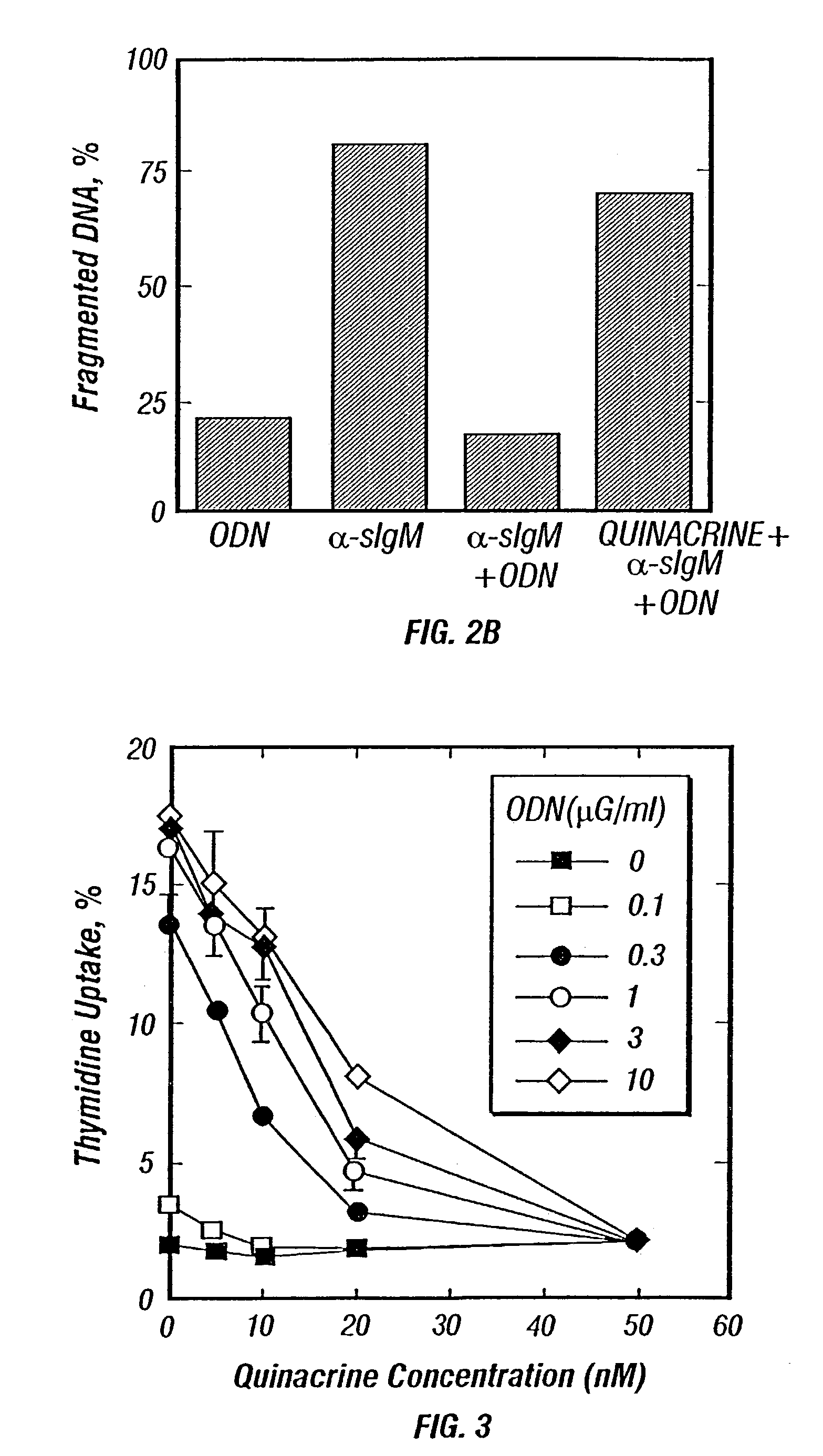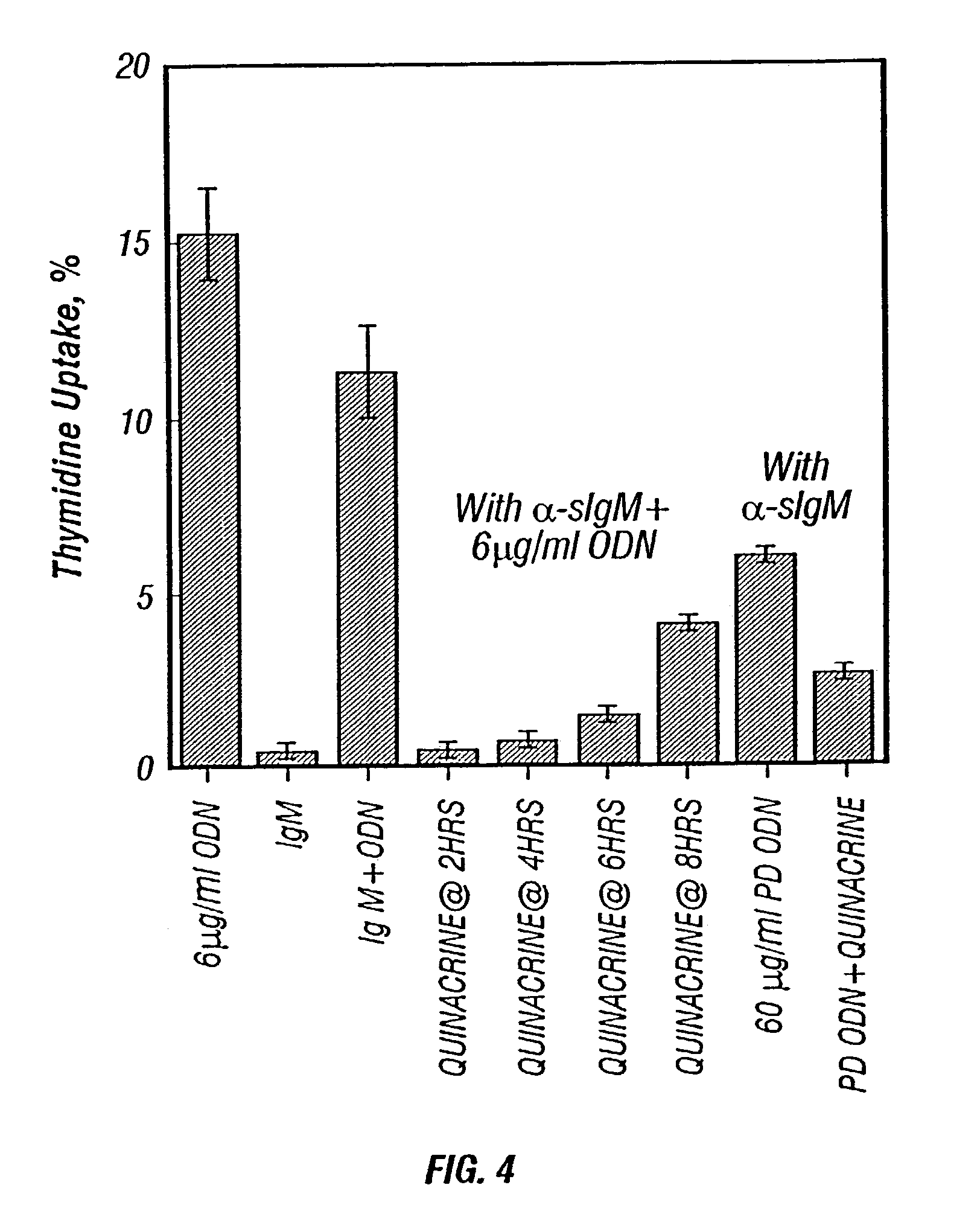Methods for inhibiting immunostimulatory DNA associated responses
a technology of immunostimulatory dna and immunostimulatory dna, which is applied in the direction of immunodeficiency, drug composition, biocide, etc., can solve the problems of endosomal hydrolytic enzyme action, receptor trafficking, and chloroquine collapse the ph gradien
- Summary
- Abstract
- Description
- Claims
- Application Information
AI Technical Summary
Benefits of technology
Problems solved by technology
Method used
Image
Examples
example 1
Simultaneous Addition of Immunostimulatory DNA and Compounds
[0071]The assay of [3H] Thymidine incorporation was carried out as follows. WEHI 231 cells (200 μL at 2×105 / milliliter, in duplicate or triplicate) were incubated in a 96-well plate (Costar, Cambridge Mass.). Additions were made as indicated. After incubating for 16 hours, 0.5 μCi [methyl-3H] thymidine (2 Ci / millimole, DuPont NEN, Boston Mass.) was added to each well, and the cells were incubated for another 4 hours. Cellular DNA was then captured onto glass fiber filters (Whatman 934AH) using a cell harvester (Brandel, Gaithersberg Md.). The filters were dried, placed into plastic scintillation vials with 10 milliliters of scintillation cocktail (EconoSafe, Research Products International, Mount Prospect Ill.), and counted in a liquid scintillation counter (Beckman LS-3133 T). The 3H recovered on the filter was expressed as a fraction of the 3H added. In a typical experiment, WEHI 231 cells incorporate about 15% of added 3...
example 2
Effect on Growth and Apoptosis
[0075]The DNA fragmentation assay was carried out generally as follows. WEHI 231 cells were incubated with 0.5 μCi / milliliter [3H] thymidine for 3 hours, centrifuged, resuspended in 2 milliliters of fresh medium at 2×105 / milliliter, and incubated in a 24-well plate with additions as indicated. After incubation for 16-18 hours, 1 milliliter aliquots of the cells were centrifuged, washed with 200 μliters PBS. This suspension was drawn into a pipette tip containing 25 μliters of 2% SDS, and the mixture was immediately ejected into a well of a 0.8% agarose TBE gel containing 0.5 μliter / milliliter ethidium bromide. The gel was electrophoresed for 1 hour at 65 volts, destained in water, and photographed under ultraviolet light. The lanes of the gel were cut into three approximately equal portions. The first portion included the gel well and the first 2 millimeters of the running lane. The second and third pieces were the remainder of the lane. The gel portion...
example 3
Effect on IL-6 Synthesis
[0078]The assay of IL6 was generally carried out as follows. WEHI cells (2×105 / milliliter) were incubated with or without ODN 1760 (6 μgram / milliliter) and with or without chloroquine or quinacrine. After 24 hours, the IL-6 content of the supernatant was assayed by enzyme-linked immunoassay using two monoclonal antibodies in a sandwich technique as described by the manufacturer, using standards supplied (PharMingen, San Diego Calif.).
[0079]Besides inhibiting apoptosis, CpG-ODN stimulated the synthesis of cytokines, including IL-6. In the absence of other additions, WEHI 231 cell elaborated about 700 picograms IL-6 per milliliter. ODN 1760 increased this elaboration to over 10,000 picograms / milliliter. The addition of quinacrine (10 nM) or chloroquine (30 nM) completely reversed the effect of ODN 1760.
PUM
| Property | Measurement | Unit |
|---|---|---|
| time | aaaaa | aaaaa |
| time | aaaaa | aaaaa |
| Acid | aaaaa | aaaaa |
Abstract
Description
Claims
Application Information
 Login to View More
Login to View More - R&D
- Intellectual Property
- Life Sciences
- Materials
- Tech Scout
- Unparalleled Data Quality
- Higher Quality Content
- 60% Fewer Hallucinations
Browse by: Latest US Patents, China's latest patents, Technical Efficacy Thesaurus, Application Domain, Technology Topic, Popular Technical Reports.
© 2025 PatSnap. All rights reserved.Legal|Privacy policy|Modern Slavery Act Transparency Statement|Sitemap|About US| Contact US: help@patsnap.com



